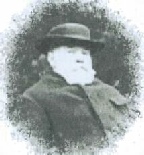Highampton Local History Group


Michael Brown Rector of Highampton for 3 2 years
Highampton in the 19th century
Memories of a Devonshire parish, as penned by the Reverend Michael Brown in 1882
HIGHAMPTON, or High-Hampton, is a small parish and village - the latter more frequently known by the name of the "Golden Inn" - about four miles west of the town of Hatherleigh, in the Union of Okehampton and Archdeaconry of Totness. Population, last census, 270. The Ven. Archdeacon Woolcombe is Lord of the Manor, and owner of the greater part of the Parish. Burdon - now the property of the Reddaway family - had been in the family of the Burdons since the time of Richard I. The Church Register dates from 1654, but many of the earlier entries are illegible. The Manor was successively in the families of the Moels, Filleigh, Holway, and Lang; it was afterwards in that of Walter, whose heiress in the 17th century brought it in marriage to the ancestor of Archdeacon Woolcombe the present proprietor. The Parish is pleasantly situated on a gentle rise, which, sloping up from the river Torridge, its northern boundary, drops gradually towards the small stream of the Wagga, as it flows through Stewdon Moor, and divides this Parish from Northlew. Although generally considered somewhat remote, the locality has many features of interest for the tourist, if he is a lover of natural scenery and an admirer of rich abundant wild vegetation - wild flowers, rare and graceful ferns and hardy lichens abound on every side, in every variety of colour and form. As the fuel used in the farm houses and cottages is chiefly procured from the hedges and copes, the trunks of the hewn down trees being left in the soil, they become gradually covered by ferns and other parasitic plants, which, creeping up, festoon themselves about these trunks, and form combinations of shape and colour of rare beauty, often coveted by town residents for their trim pleasure grounds. Here, too, the admirer of foliage plants may match the choicest treasures of his green-house, so he gathers the tender shoots of the little hedge-row oaks, with their small pointed rich brown and crimson leaves, shining like burnished bronze in the sun light. The Church, which is situated on the highest point of the above mentioned ridge, is a plain, but pretty structure, rebuilt in 1833, all but the ancient Norman porch, which still remains and contains some good specimens of old wood carving. From the top of the Church Tower, in clear weather, most extensive and attractive views meet the eye on every side. On the north-east, where the greatest distance is reached, we have every variety of homely English scenery, a rich rolling landscape, well cultivated, over which weather-beaten grey church towers lie scattered, each with its clustering, thatch roofed village, gleaming white. Here and there, neat farm houses, elegant country seats, stand in their sombre woods, through which glimpses of the Torridge break, as it rolls on to Bideford and the sea. This extensive stretch of landscape is bounded by the dim outline of Exmoor, at least 35 miles distant. To the extreme west lie the Cornish hills beyond Launceston over 20 miles away, so that the eye ranges over a most magnificent stretch of country, more than 50 miles across.
To the south and south-east, the view is most peculiar, and quite unusual in England, a wide expanse of moorland, varied by patches of cultivation, stretches away, and is abruptly stopped by the north-west edge of Dartmoor, which reaches from Cawstone Beacon to Lynx Tor, and then, bending straight to the west, is continued on the lower range of Broadbury, along which runs the Holsworthy branch of the L.& S.W.R.
This sudden termination of a level county adds to the apparent height of the hills, so that in certain states of the atmosphere, they assume the proportions of mountains although the highest point is little over 2,000 feet. Wild and strangely beautiful are the stretches of moorland lying before the spectator, and reaching to the tops of these hills. Rarely relieved, as it is, by dark clusters of pine trees, it presents much the same surface, as it did when the icebergs went up in mists leaving the tors behind them for a perpetual remembrance, ever the same except when it sleeps under the snow. In the spring patches of green and yellow gorse may sometimes be visible, but they are short-lived ornaments, they soon fade away, and then the old moor assumes its usual sombreness — as an aged grandmother, early in the day, puts by the few festive ornaments she wears in honour of the wedding feast of her grand-child, and is again seen in her usual homely dress
Turning to the east, we see the imposing church steeple and white houses of the charmingly situated town of Hatherleigh, answering almost exactly to Dr. Farrar's graphic description of Nazareth. Further still, the landscape rises, until the view is terminated by a low range of hills which stretch in a northerly direction, from Winkleigh, until they seem to melt into the more distinct outline of Exmoor.
Copyright © site designed by the late Simon Ward and managed by his wife Carole
| Contacts |
| Highampton in 19th Century |
| The Ancient Feudal Manor of Burdon, Devonshire |
| Photos |
| Useful Links |
| Dunsland House |